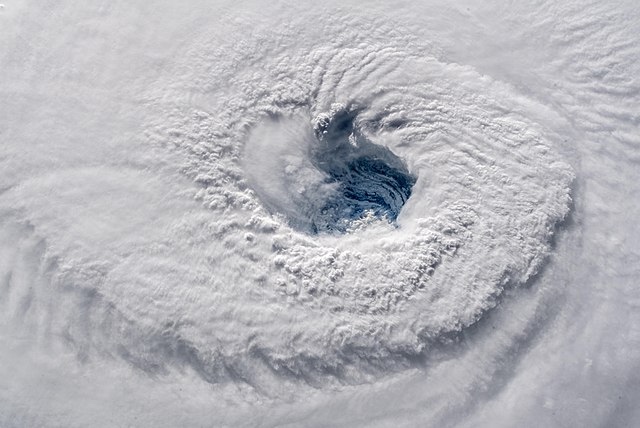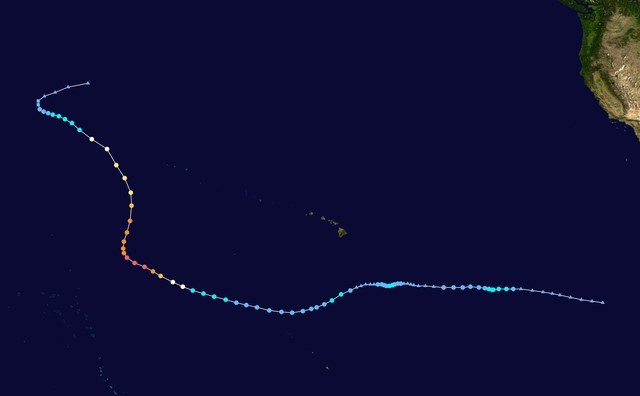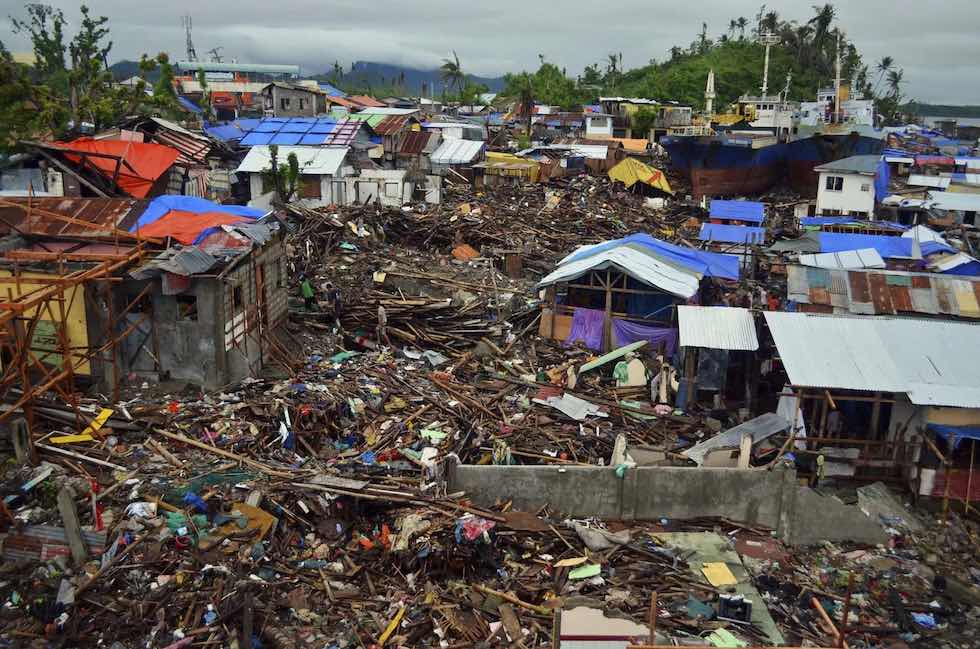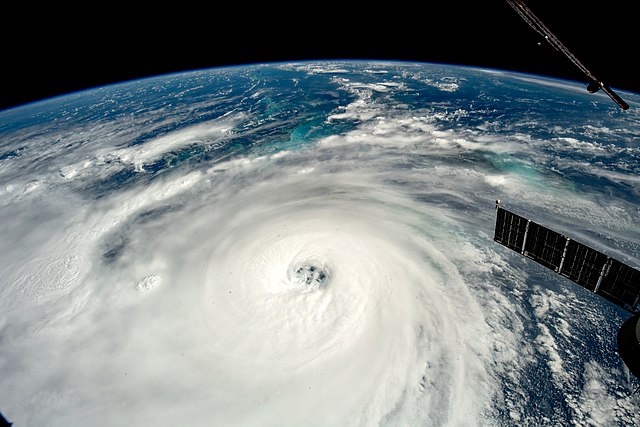Hurricanes and typhoons are components of a tropical cyclone - a huge mass of clouds that gathers in the sky, rotating counterclockwise at low pressure. Subsequently, it collects moisture, increasing in size. At the center of a cyclone, there is a circular area called an eye. The weather in this area is relatively calm. The eye is surrounded by an eye wall - a ring of thunderstorms with strong winds and the most severe weather conditions.
 Image source: Wikipedia
Image source: Wikipedia
Cyclones always form above seas or oceans only in tropical and subtropical zones, because they need warm ocean waters to gain strength. The warm air from the water comes into contact with the upper chilled air masses, creating clouds. The resulting precipitation transfers heat to the atmosphere. Colliding with each other, air masses of different temperatures form a low-pressure center, which becomes the birthplace of typhoons or hurricanes.
Tropical cyclones are not always a serious threat to people. They happen more often than you think, but only a few gain enough power to become hurricanes or typhoons. The weakest tropical cyclone is called a tropical depression. This is still the same swirling mass of clouds that comes with tropical storms, but the wind speed is not as high. The strongest gusts can reach up to 39 miles per hour, but it happens quite rarely. During such weather, you will only have to close the windows and doors and stay home.
And if you find yourself at sea during a tropical depression, it can be a serious problem for you, because the wind speed will be enough to turn your boat upside down. Not to mention storms with showers and lightning, when wind speeds exceed 40 mph. Such a cyclone is called a tropical storm. Wind gusts can reach 80 mph. If its speed is even higher, then such a cyclone is called a hurricane or typhoon.
What Is the Difference Between a Typhoon and a Hurricane?
There is almost no difference between a hurricane and a typhoon. Both of them are tropical cyclones, and the only difference is their origin. Tropical cyclones with wind speeds of over 74 miles per hour forming in the North Atlantic Ocean or Northeast Pacific are called hurricanes. And if such a cyclone forms in the Northwest Pacific Ocean, then it’s a typhoon.
Interestingly, when a cyclone occurs over the South Pacific or Indian Ocean, it doesn’t change its title and is called a tropical cyclone no matter the wind speed and strength. In all other respects, these weather phenomena are identical. A hurricane can become a typhoon and vice versa if it moves from one area to another and crosses the International Date Line at 180 degrees west longitude. For example, in 2014, Hurricane Genevieve crossed this line and turned into Typhoon Genevieve.
 Genevieve’s path. Image source:: Wikipedia
Genevieve’s path. Image source:: Wikipedia
We hear about hurricanes more often than typhoons because the Atlantic Ocean is warmer than the Pacific, and its waters are more likely to become “fuel” for cyclones. Ocean water evaporates from the surface. Then the water vapor condenses in the cold air, forming clouds that in turn gather together and begin to rotate in the wind. Thus, hurricanes can cover vast areas and, under the right conditions, turn into real monsters.
Categories of Typhoons
According to Japan Meteorological Agency, typhoons are classified as follows:
| Category | Sustained winds |
|---|---|
| Tropical depression | ≤37 mph |
| Tropical storm | 38-54 mph |
| Severe tropical storm | 55-72 mph |
| Typhoon | 73-97 mph |
| Very strong typhoon | 98-120 mph |
| Violent typhoon | ≥121 mph |
The strongest typhoon ever is currently Typhoon Haiyan, which occurred in November 2013 over the Philippines, with the speed of about 193 mph and over 6,000 fatalities.
 Damage to the city of Tacloban, Philippines. Image source: Britannica
Damage to the city of Tacloban, Philippines. Image source: Britannica
Categories of Hurricanes
The Saffir-Simpson Scale is a scale for measuring potential damage from hurricanes, developed by Herbert Saffir and Robert Simpson in 1969. It is based on sustained winds speed and includes an estimate of storm waves in each of the five categories.
The World Meteorological Organization recommends measuring sustained winds at a height of 33 ft for 10 minutes and then taking the average. The U.S. National Weather Service uses the same height but defines sustained winds as average winds over 1 minute.
The categories according to the Saffir-Simpson Scale are as follows:
| Category | Sustained winds |
|---|---|
| Category 1 | 74-95 mph |
| Category 2 | 96-110 mph |
| Category 3 | 111-130 mph |
| Category 4 | 131-155 mph |
| Category 5 | ≥156 mph |
- Category 1. Winds are slightly stronger than those during a tropical storm. In some countries, Category 1 hurricanes are considered storms. Wind speeds can reach 90 mph.
- Category 2. Winds are blowing at a speed of up to 100 mph. The gusts are so strong that trees and billboards begin to fall, so it is dangerous to be outside.
- Category 3. This wind is already considered a natural disaster. It reaches speeds of 130 mph and is accompanied by torrential rains and thunderstorms. It is best to hide in a basement or other fortified shelter.
- Category 4. Gusts reach 155 mph, trees are falling, and quite large objects are rotating in the air. The last recorded Category 4 hurricane occurred in September 2022 under the name Ian, with wind speeds reaching 155 miles per hour and over 160 victims.
 Image source: Wikipedia
Image source: Wikipedia - Category 5. This type of hurricane can blow away the roofs and destroy entire buildings. It can cause complete and extremely prolonged power outages and water loss, possibly for up to several months. The 1935 Labor Day hurricane is considered the strongest hurricane that ever made landfall in the United States. Wind speeds reached an incredible 185 miles per hour. The infamous Katrina, which caused massive flooding in Louisiana, was also assigned Category 5.
Why are names given not only to hurricanes, but to all tropical cyclones whose wind speeds exceed 60 miles per hour? This is not done for fun. When several cyclones occur in the same area at once, it is easy to confuse them. Therefore, to avoid confusion in weather forecasts and news, each tropical cyclone gets a name.
Conclusion
So is there any difference between a hurricane, cyclone, and typhoon? These are different names for the same weather phenomenon - a strong cyclonic vortex in the atmosphere. The term “hurricane” is most commonly used in North America and the Caribbean. “Typhoon” is a term used to refer to the same phenomenon in the Pacific region, including South China, Japan, and the Philippines.
Unfortunately, no matter the type of weather phenomena, many of them can have devastating consequences, that’s why it’s important to be prepared beforehand. With RainViewer’s Storm Tracker feature, you can get notifications about storm formation, follow its path on the live map, and find out if it is close to your location. Be ahead of the storm and stay safe!






